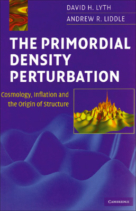by David Lyth and Andrew Liddle, Cambridge University Press. Hardback ISBN 9780521828499, £40 ($75). E-book ISBN 9780511536922, $60.

In the early 1990s, the discovery of minute inhomogeneities in the temperature of the cosmic microwave background (CMB) marked the beginning of an observational endeavour that continues today thanks to dedicated satellite missions, such as the Wilkinson Microwave Anisotropy Probe and Planck. Current observations seem to suggest that the CMB anisotropies and polarization stem from inhomogeneities of the spatial curvature, which are related via general relativity to the fluctuations of the energy density. The latter fluctuations are often called, in the jargon, density perturbations. This monograph by David Lyth and Andrew Liddle unveils the different facets of the interplay between density inhomogeneities, quantum field theory and observational astrophysics. It follows (and partly overlaps with) Cosmological Inflation and Large-Scale Structure, written less than nine years ago by the same pair of authors.
The Primordial Density Perturbation is organized into three parts. The first and second parts provide a swift reminder of concepts connected to relativity (both special and general) and the Standard Cosmological paradigm (sometimes dubbed the ΛCDM model where Λ stands for the dark-energy component and CDM is the acronym for cold dark matter). The third part of the book, titled “Field Theory”, collects all of those aspects of quantum-field theory that are germane to the evolution and normalization of cosmological perturbations. The section’s main focus is organized around the description of space–time geometry in its most relativistic regime, i.e. when the typical wavelengths of the fluctuations in the spatial curvature are comparable with the Hubble radius, whose size is a million times larger than the extension of a typical spiral galaxy, such as the Milky Way.
Despite the excellent effort made by the authors, it seems necessary – especially for students and novices – to keep other dedicated books about quantum field theory on hand as well as books about cosmology (appropriately quoted through the 29 chapters of the text), such as the monumental Cosmology by Steven Weinberg (Oxford University Press 2008) and the reference treatise of the early 1990s Principles of Physical Cosmology by Jim Peebles (Princeton University Press 1993).
The rich literature that is flourishing these days on the mutual interplay between the microphysics probed by particle accelerators and the macrophysics scrutinized by astrophysics and cosmology suggests an increasing interest in these themes among a community that ranges from undergraduate students to skilled practitioners of the field. The different treatises are in agreement on one aspect: the unknown territory to be charted by the LHC will influence not only the forthcoming path of particle physics but also the development of cosmology and high-energy astrophysics during the next two decades.





